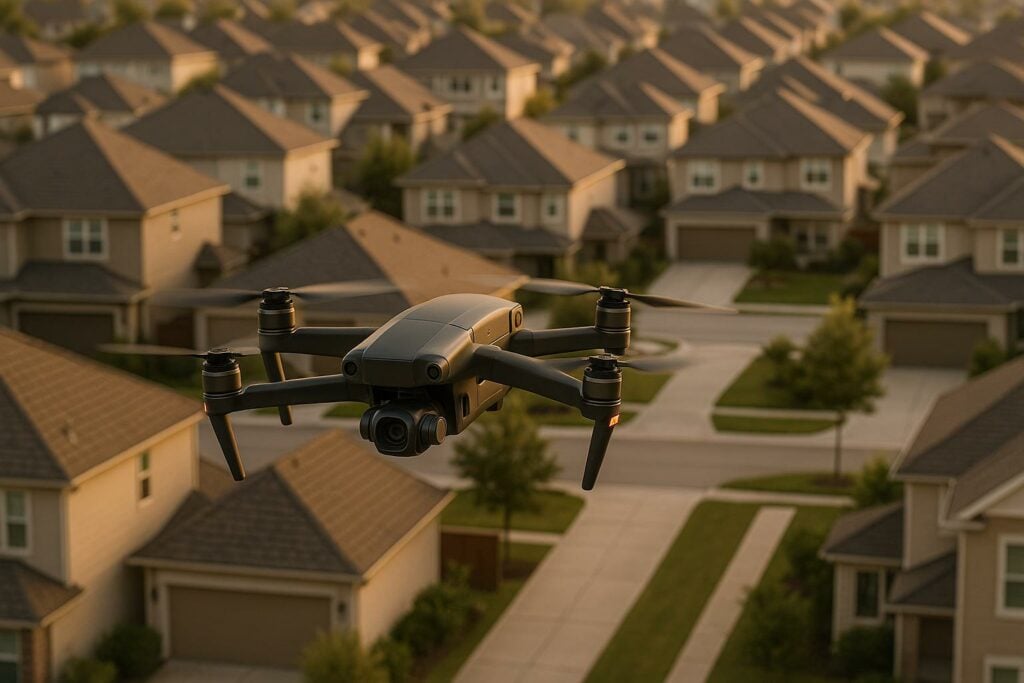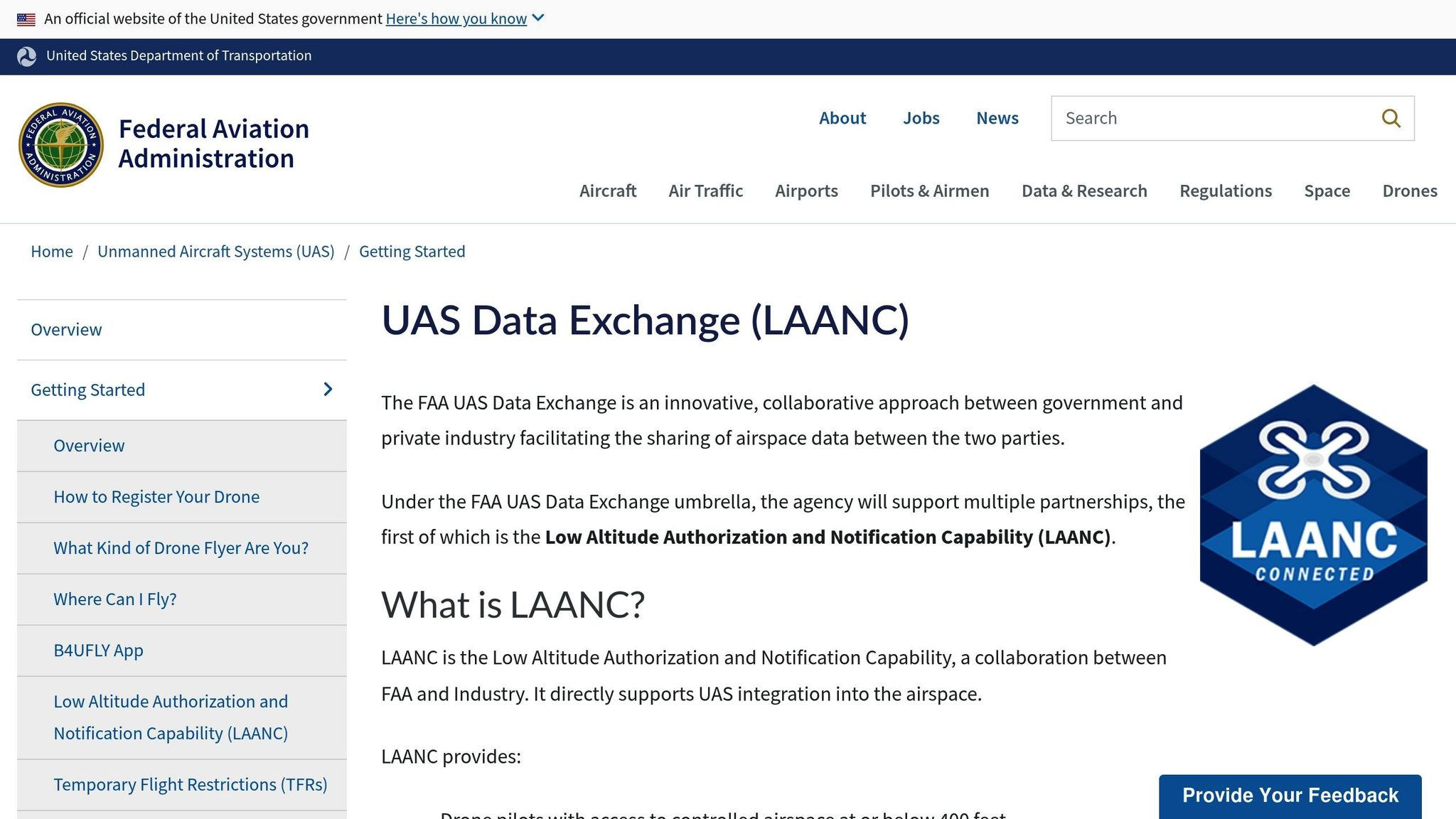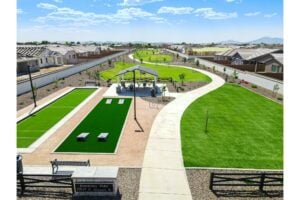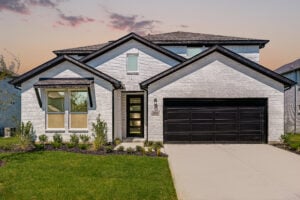Flying drones for real estate photography? You need to follow FAA rules to avoid fines, delays, and legal trouble. Here’s what you need to know:
- FAA Part 107 Rules: Required for commercial drone use. Covers altitude limits, airspace classifications, and controlled airspace permissions.
- Controlled vs. Uncontrolled Airspace: Controlled airspace (Classes B, C, D, E) needs FAA authorization; uncontrolled airspace (Class G) doesn’t.
- 400-Foot Altitude Limit: Stay under 400 feet above ground level, except when flying near tall structures.
- No-Fly Zones: Includes military bases, federal sites, national parks, and temporary restrictions like wildfires or VIP events.
- LAANC System: Use this tool for near-instant authorization in controlled airspace.
Key Tip: Use FAA-approved apps like B4UFLY or AirMap to check airspace restrictions in real time. For complex projects, professional drone services like HomeJab handle compliance and deliver high-quality results. Always document flights, maintain insurance, and stay updated on regulations to protect your business.
How To Get FAA Airspace Authorization Using LAANC
FAA Airspace Types and Drone Rules
If you’re using drones for real estate photography, knowing the FAA’s airspace classifications isn’t optional – it’s essential. Each airspace class comes with its own rules, which dictate where and how you can fly. A key first step is understanding the difference between controlled and uncontrolled airspace, so you can plan safe and legal flight paths.
Controlled vs. Uncontrolled Airspace
Controlled airspace includes Classes B, C, D, and E, where air traffic control (ATC) oversees aircraft movement. Here’s a quick breakdown:
- Class B: Covers major airports like LAX and JFK, extending up to roughly 10,000 feet.
- Class C and D: Found around medium and smaller airports, with ceilings of about 4,000 feet and 2,500 feet, respectively.
- Class E: Begins at 700 or 1,200 feet above ground level (AGL) in most areas.
On the other hand, Class G airspace is uncontrolled, meaning ATC does not manage flights here. This airspace lies below the altitudes specified for controlled airspace. If you’re flying in controlled areas, you’ll need authorization through systems like LAANC (Low Altitude Authorization and Notification Capability). In Class G, no prior permission is required.
The 400-Foot Height Limit Rule
One of the most important rules for drone pilots operating under Part 107 is the 400-foot altitude limit. You must keep your drone at or below 400 feet AGL. However, there’s an exception: you can fly up to 400 feet above a structure’s highest point. For instance, if you’re photographing a 200-foot building, your drone can legally reach 600 feet AGL.
This height restriction ensures drones stay well below the flight paths of manned aircraft. For real estate photography, staying within this limit still allows you to capture stunning, wide-angle views of properties and their surroundings. Keep in mind that your drone’s altimeter measures altitude relative to your takeoff point – not the actual ground level. If you’re flying over uneven terrain, this can affect your true altitude.
Zero-Altitude Zones and Restricted Areas
Some areas are off-limits for drone flights altogether, regardless of altitude. These zero-altitude zones are often located around sensitive sites like military bases, federal facilities, and critical infrastructure. The FAA designates these as "No Drone Zones" to safeguard national security and public safety.
Military installations, in particular, enforce strict no-fly rules, often supported by counter-drone technologies. Other restricted areas include federal prisons, nuclear power plants, major sporting events, and the airspace around Washington, D.C. Some restrictions are temporary, such as those put in place during large events or heightened security periods.
Before flying, always check FAA-approved apps for updates on temporary restrictions, which can pop up with little notice. If you see a "No Drone Zone" sign on a property, it likely means local rules prohibit takeoff and landing there. However, flying above the property may still be possible if you secure proper authorization.
If you need to operate in a zero-altitude zone near a Department of Defense site, you’ll have to apply for an FAA waiver. This process involves coordination with both the FAA and the military installation’s security team. It can take months to complete and may include a background check for the pilot. Plan accordingly if your project requires access to these highly restricted areas.
No-Fly Zones and Temporary Flight Restrictions
Understanding where drones are prohibited is just as important as knowing where they can fly. No-fly zones and Temporary Flight Restrictions (TFRs) can be enforced with little notice, and violating them could lead to hefty fines or legal trouble. For real estate professionals, staying informed about these restrictions is critical. Below, we break down how to identify both permanent and temporary no-fly areas.
Finding Permanent No-Fly Zones
Permanent no-fly zones are designated around areas that are vital to national security or public safety. For instance, drone flights are restricted in many national parks under regulations set by the National Park Service. These rules typically prohibit both launching and landing drones within park boundaries. Airports also impose strict airspace controls. Larger airports operate under complex airspace classifications that often require special FAA authorization for drone operations, while even smaller regional airports enforce altitude and distance limits to ensure safety. Additionally, federal sites critical to national security maintain strict no-fly rules. To avoid issues, always check the latest FAA guidelines and local regulations before planning flights near these areas.
Temporary Flight Restrictions (TFRs)
Temporary Flight Restrictions can pop up with minimal warning. They are often issued in response to events like wildfires, large public gatherings, or emergencies. For example, during wildfire suppression efforts, the FAA may establish TFRs around affected areas to ensure the safety of firefighting aircraft. Similarly, major events or VIP movements – such as presidential visits – can result in temporary airspace limitations. Emergency situations, including search and rescue operations, hazardous incidents, or security threats, can also lead to rapidly changing TFRs. Staying updated on FAA notifications is essential to avoid disruptions.
FAA-Approved Apps for Airspace Awareness
To stay compliant and informed, drone operators can rely on FAA-approved tools like the B4UFLY app, which provides real-time, color-coded airspace updates. Additionally, LAANC-enabled apps, including AirMap, Aloft, and SkyGrid, not only offer detailed airspace information but also allow users to request flight authorizations directly through FAA systems.
For those who need more in-depth data, apps like ForeFlight provide sectional charts, airport details, and comprehensive TFR updates. Although ForeFlight is primarily designed for manned aircraft pilots, its advanced features can be valuable for professional drone operators. However, since app updates may sometimes lag, it’s a good idea to cross-check information using multiple sources.
Real estate professionals using services like HomeJab can rely on these tools to plan drone operations efficiently, ensuring projects stay on schedule without unexpected delays.
Getting FAA Permission for Restricted Airspace
If you’re planning to capture drone photography in controlled airspace, getting FAA authorization is a must. Thankfully, the process is designed to be straightforward, making it easier for professionals to gain access to restricted areas. Let’s break down how the FAA’s approval process works.
LAANC System for Fast Approvals
The Low Altitude Authorization and Notification Capability (LAANC) system has revolutionized the way airspace permissions are handled. This system, a collaboration between the FAA and private industry, automates the application and approval process, allowing real estate professionals and other users to access controlled airspace at or below 400 feet.
Here’s how it works: LAANC facilitates data sharing between the FAA and FAA-Approved UAS Service Suppliers (USS). It automatically checks your request against various airspace data sources, such as UAS Facility Maps, Special Use Airspace data, Airports and Airspace Classes, Temporary Flight Restrictions (TFRs), and Notices to Airmen (NOTAMs). This automation ensures that your request is processed quickly and aligns with existing airspace rules.
The best part? You can get near real-time approval for your flight by submitting details like the date, time, altitude, and location of your planned operation. Accessing LAANC is simple – you can use desktop applications or mobile apps provided by FAA-Approved UAS Service Suppliers.
Keep in mind, though, that LAANC only provides airspace authorizations. You’ll still need to review NOTAMs, check weather conditions, and adhere to any additional airspace restrictions that might apply. Always double-check these factors to ensure a safe and compliant flight.
sbb-itb-82c5f45
Best Practices for Real Estate Drone Operations
Operating drones for real estate isn’t just about following FAA rules – it’s about blending compliance, safety, and effective marketing to showcase properties in the best possible light. Professionals who succeed in this space rely on solid practices to ensure smooth operations and outstanding results.
Pre-Flight Planning and Compliance
A well-prepared flight is the foundation of safe and compliant drone operations. Every mission should start with a thorough pre-flight checklist that covers equipment readiness, airspace regulations, and weather conditions.
Use FAA-approved tools or the LAANC system to check for any airspace restrictions or Temporary Flight Restrictions (TFRs) that might impact your flight. Notices to Air Missions (NOTAMs) are updated frequently, so staying informed is critical. Weather is another key factor – poor conditions can compromise drone performance and safety.
Documenting your flight plans is a must. Record details like the property address, flight path, maximum altitude, and any special considerations, such as nearby airports or populated areas. This documentation not only helps with operational planning but also serves as proof of compliance if questions arise.
If this level of preparation feels overwhelming, consider hiring professional drone services to handle the complexities for you.
Using Professional Drone Services
Professional drone services can simplify compliance and elevate the quality of your marketing materials. With over 400,000 commercial drones and 460,000 certified remote pilots in the U.S., the industry offers plenty of options for real estate professionals.
These services employ certified Part 107 pilots who are well-versed in the latest FAA regulations. They take care of airspace authorizations, carry appropriate insurance, and use advanced equipment to deliver high-quality aerial imagery that enhances property listings.
"The FAA’s regulatory framework is dynamic, making it essential to have experts who are updated on changes and can guide through compliance complexities." – Anzen Unmanned
Professional operators also bring capabilities that go beyond what most real estate agents can manage on their own. For example, operations requiring Beyond Visual Line of Sight (BVLOS), flights over people, or navigating complex airspace often need specialized waivers and expertise – areas where professional services excel.
Platforms like HomeJab make it easy to connect with vetted, FAA-compliant drone operators nationwide. These professionals are certified, equipped with advanced tools, and deliver high-quality imagery with a quick 24-hour turnaround. Their services ensure compliance and create stunning visuals that can be seamlessly integrated into virtual tours, social media posts, and property presentations. Aerial footage adds a unique perspective, highlighting a property’s layout, surroundings, and overall appeal in ways ground-level photos simply can’t match.
Record Keeping and Risk Management
Strong record keeping is essential for maintaining safe, compliant, and professional drone operations. Detailed flight logs should include the date, time, location, weather conditions, and any required authorizations. Additionally, keep copies of your Part 107 certificate, drone registration, and insurance documents on file.
Speaking of insurance, it’s crucial to have dedicated drone coverage. Standard real estate errors and omissions policies often exclude drone-related incidents. Specialized insurance can protect you from risks like property damage, privacy claims, or regulatory fines.
Tracking airspace authorizations is another critical part of risk management. LAANC approvals often come with conditions, such as altitude limits or time restrictions, which must be followed to avoid penalties. Keep these approvals with your flight logs and review them before each flight.
Regular maintenance and calibration of your equipment are equally important. Document software updates, compass calibrations, and any hardware issues. These records can be invaluable if you need to file an insurance claim or respond to a regulatory inquiry.
Finally, establish clear protocols for unexpected situations. Whether it’s encountering other aircraft, emergency vehicles, or law enforcement, have a plan in place to ensure immediate compliance. Landing and documenting the incident demonstrates professionalism and protects all parties involved.
Conclusion: Safe and Legal Drone Operations
This guide has covered the essential FAA regulations and practical tips for operating drones safely and within the law. Understanding airspace classifications, using tools like LAANC, and following Part 107 requirements are all key to staying compliant and avoiding issues.
Knowing airspace classifications is crucial for avoiding violations and ensuring safety. Whether it’s controlled airspace near airports, restrictions around emergency zones, or no-fly areas near sensitive locations, being aware of where you can and cannot fly is non-negotiable.
Tools like LAANC make navigating controlled airspace easier by offering quick approvals when paired with real-time airspace apps, streamlining the process for operators.
Part 107 certification remains a must-have for commercial drone pilots. Staying updated on changing regulations, carrying appropriate insurance, and maintaining detailed flight logs not only demonstrate professionalism but also help mitigate risks.
For those navigating complex rules or seeking high-quality results, professional services like HomeJab (https://homejab.com) provide certified operators who ensure compliance while delivering exceptional aerial imagery.
As drones continue to play a growing role in real estate marketing, the spotlight on safe and legal operations has never been brighter. Adhering to regulations and prioritizing safety not only protects the industry’s reputation but also ensures ongoing access to airspace for legitimate commercial purposes.
The key to success in real estate drone operations lies in understanding the rules, respecting airspace boundaries, and making safety the top priority for every flight.
FAQs
What’s the difference between controlled and uncontrolled airspace for flying drones?
Controlled airspace comes with strict rules, especially near airports or in areas with heavy air traffic. If you’re flying a drone in these zones, you’ll need authorization from air traffic control, particularly for operations above 400 feet AGL (above ground level).
In contrast, uncontrolled airspace offers more freedom. Drone pilots can usually operate without prior approval, provided they stay under 400 feet AGL and follow FAA regulations – like steering clear of restricted areas and keeping the drone within visual line of sight.
The key distinction lies in the level of regulation: controlled airspace demands explicit clearance to ensure safety, while uncontrolled airspace allows for more independent operation.
How can I quickly get FAA approval to fly a drone in controlled airspace?
How to Get FAA Approval for Controlled Airspace
If you need quick FAA approval to fly in controlled airspace, the Low Altitude Authorization and Notification Capability (LAANC) is your best bet. This system streamlines the process, giving you near real-time authorization. You can access LAANC through the FAA DroneZone or approved third-party apps, with most approvals taking just a few minutes.
For real estate professionals, LAANC is a game-changer. It allows you to legally and safely operate drones in restricted areas, making it easier to comply with FAA rules while capturing breathtaking aerial shots for property listings.
How can I ensure my drone operations for real estate photography comply with FAA regulations?
To legally use a drone for real estate photography, you need to follow the FAA’s guidelines. First, register your drone with the FAA and keep proof of registration with you at all times. Then, obtain a Remote Pilot Certificate under Part 107 by passing the FAA’s knowledge test.
When flying, stick to these key rules: operate only during daylight hours, keep the drone within your visual line of sight, and steer clear of restricted or sensitive airspace unless you’ve received prior FAA authorization. If you need to fly in restricted areas, make sure to request and secure the necessary permissions ahead of time.
Following these steps ensures you can safely and legally use drones to elevate your real estate photography while staying compliant with federal laws.












